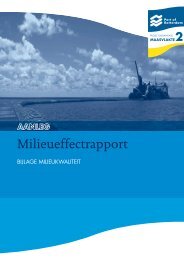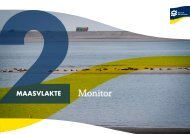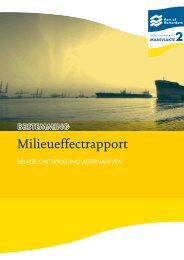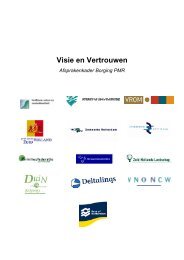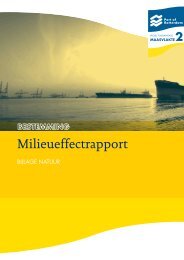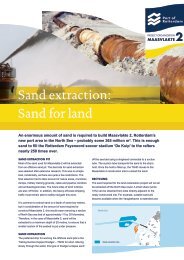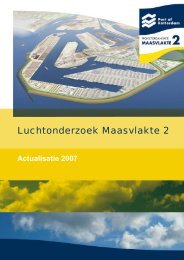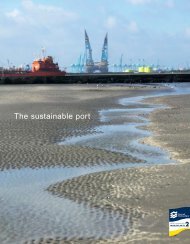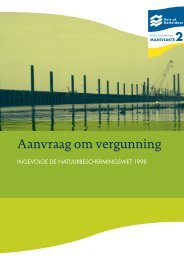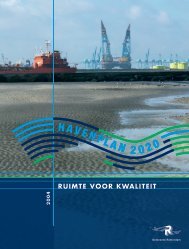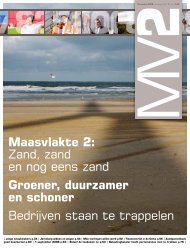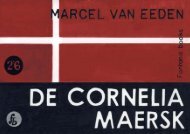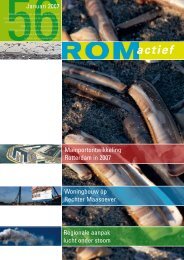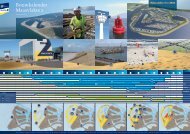brochure - Maasvlakte 2
brochure - Maasvlakte 2
brochure - Maasvlakte 2
Create successful ePaper yourself
Turn your PDF publications into a flip-book with our unique Google optimized e-Paper software.
SOLAR BELL<br />
Solar Bell represents a new utopia<br />
The Portscapes art project started with a dream: <strong>Maasvlakte</strong> 2, new land from the sea. The<br />
myth of Atlantis, the utopian paradise where people live in abundance and harmony and which,<br />
according to folklore, was lost to the destructive forces of nature. Now, over 5 years later, a new<br />
utopia beckons: Tomás Saraceno’s Solar Bell project. A world not made from sand and cement,<br />
but from air and new materials like carbon fibre. Designed and built not because of but in spite<br />
of gravity.<br />
From 2008-2013, Portscapes walked an exciting route along landmarks drawn by artists.<br />
Through a diffuse space that slowly found its contours. A space where the seemingly long felt<br />
dichotomy between nature and culture gradually faded. In the artists’ works, there was an<br />
increasing focus on the interaction between people and nature. The fact that human activity<br />
affects the planet and the atmosphere, and that this influence can be intentionally used,<br />
began to receive more and more emphasis.<br />
<strong>Maasvlakte</strong> 2 is a witness to this influence. Man can create new land in a short period of<br />
time, while geological processes would take much longer. But at the same time, this influence<br />
is relative. Man is ultimately no match against the forces of nature and the effects of time.<br />
Man perishes, but the world does not.<br />
With his latest project, Solar Bell, the visionary artist Tomás Saraceno shares his dreams and<br />
ideas and adds a new chapter to Italo Calvino’s influential book ‘Invisible Cities’ (especially<br />
the chapter ‘Cities & The Sky’). The wind, often a source of inspiration for Saraceno, is not<br />
just a gust of air. Saraceno sees a dynamic solar wind that will one day propel star ships<br />
through the atmosphere. Wind that creates energy and generates production, consumption<br />
and distribution. Saraceno: “These dreams remind us of the time when architecture and art<br />
were a form of communication between man and his natural environment. There was a kind<br />
of symbiosis between the two, interaction without domination.”<br />
In our interactive, digital age, we share and collect information freely. The technical means<br />
for this are increasingly tailored to our ability to think, act and cooperate. Saraceno: “When<br />
the needs of a society change and evolve over time, cities will change and new forms will<br />
develop.” Saraceno wonders why cities are not created with the cooperation and help of<br />
engaged citizens. Cities with forms made by and for the user. Where new use of space arises<br />
and where all the creative, social and economic potential is mobilised and used. Saraceno<br />
dreams of cities flying on the wind. “If it’s as windy as in my dreams, then the kite-city would<br />
actually take off. Imagine: buildings lifted up by wind energy, an entire city flying through<br />
the air, following the atmospheric conditions.”<br />
It can’t be a coincidence that Solar Bell bears the name of the inventor Alexander Graham<br />
Bell. The man who invented the telephone in 1875, the form of communication that changed<br />
the world. But Bell was also fascinated by flying objects. Saraceno’s flying sculpture is<br />
laminated with whisper-thin solar panels and it makes a noise. The wind energy becomes a<br />
symphony, an ode to the ideas and visions of artists, utopians and inventors.<br />
“Utopia, extropia, atopia, dystopia, and more … I need them all”, Saraceno says. He dreams<br />
of them every night. Possibilities and impossibilities, the perfect scenario and failure.<br />
Utopian dreams lead us to the impossible. Jules Verne said “All that is impossible remains<br />
to be achieved.” In other words, if man does not set his sights high, there is no progress.<br />
As far as Saraceno is concerned, utopia includes everything and everyone. Together, having<br />
the courage to dream and to opt for many possible futures. Art can make an important<br />
contribution here. If man wishes for something, it can be achieved. The problem lies in<br />
recognising the potential of these wishes. Many brilliant ideas are already present and only<br />
need to be recognised and interpreted to become reality.<br />
“Between earth and space, between art, architecture, ecology, meteorology and astrophysics,<br />
traditional borders that stand in the way of progress dissolve,” says Tomás Saraceno. Playing<br />
is one of the learning processes in life. “It is the cultivation of what we do not think is<br />
possible, to be able to float.”<br />
As the physicist Johannes Kepler said: “(…) the ways by which men arrive at knowledge of<br />
the celestial things are hardly less wonderful than the nature of these things themselves.”<br />
ENG



